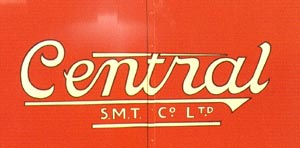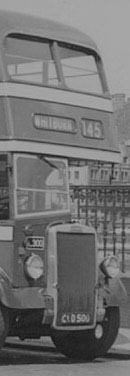The Central Story
1926 - 1960 : The Early Days
The Central SMT story begins in 1926, when the Glasgow General Omnibus Company was formed ... in Hamilton! A strange name indeed for a Lanarkshire company in those days, when the county had a quite distinct identity from its big-city neighbour. The new company had links with London General, even to the extent of operating a largely AEC fleet in its first few years. As little as two years later, however, the London connection had been severed and new ties were formed with the Scottish Motor Traction company (SMT) of Edinburgh. Glasgow General expanded its Lanarkshire operations through acquisition of small independents and, as early in its life as 1928, it had already begun competitive activity to the north-west of Glasgow, in Dunbartonshire. The company built Waterloo Street Bus Station in Glasgow in 1929 and for a short time was headquartered there.
By 1930 the company was feeling the strain of all this initial expansion and, when an offer was made by the London, Midland and Scottish railway (LMS), it was quickly accepted. LMS was also successful in acquiring a further two Lanarkshire operators : Stewart & McDonald of Carluke and Torrance of Hamilton. A complete re-structuring took place in 1932. Both Stewart & McDonald and Torrance were absorbed into Glasgow General, which at the same time became a subsidiary of SMT in Edinburgh, changing its name in the process to Central SMT Co Ltd. LMS had a quarter share of SMT, with a further quarter share held by rival rail operator LNER. The newly-renamed company undertook further expansionist activity by swallowing several smaller, independent operators.
While all this was going on, a parallel branch of the family tree was itself blossoming in Lanarkshire. The origins of this branch go back even earlier : to 1899, in fact, when the Hamilton, Motherwell and Wishaw Tramways Company was formed, changing its name shortly thereafter to Lanarkshire Tramways. This company's bus operations were given a substantial boost in 1925, when it acquired the Monklands services of Scottish General Transport, which was moving out of Lanarkshire to Kilmarnock, eventually to become Western SMT. (The historic Western SMT link with Monklands would be kept alive for many years by service 42, Airdrie - Ayr.) Lanarkshire Tramways abandoned its tram operations in 1931 and the following year - an incredibly eventful one for our company! - it agreed to be taken over by Central SMT. Central wasted no time in relocating its headquarters to the offices of its new acquisition : Traction House in Motherwell.
 The much enlarged Central SMT continued a process of growth by acquisition, taking over a string of independents in both Lanarkshire and Dunbartonshire. The incoming post-war Labour government pursued a nationalisation agenda in many sectors of the UK economy and public transport was no exception. LMS and LNER both became part of the new British Railways. An agreement was reached in 1949 whereby SMT sold its bus interests (including Central SMT) to the British Transport Commission and the bus operations thereby entered state ownership.
The much enlarged Central SMT continued a process of growth by acquisition, taking over a string of independents in both Lanarkshire and Dunbartonshire. The incoming post-war Labour government pursued a nationalisation agenda in many sectors of the UK economy and public transport was no exception. LMS and LNER both became part of the new British Railways. An agreement was reached in 1949 whereby SMT sold its bus interests (including Central SMT) to the British Transport Commission and the bus operations thereby entered state ownership.
As the economy gradually recovered in the post-war years, Central started to re-invest in the business and built up a substantial fleet of Leyland Titan double-deckers with a variety of lowbridge bodywork styles. Some variety was provided by Guy Arab double- and single-deck buses. A further notable acquisition for Central was its takeover of the Clydebank local services of Glasgow Corporation, in 1955. Another event taking place in 1955, and which would turn out in retrospect to be a momentous one, was the arrival of the first Bristol Lodekka double-deckers. This type was to a revolutionary new design, managing to achieve a lowbridge overall height, while still allowing a 2+2 seating layout on the upper deck.
The company entered the swinging sixties in confident mood, seemingly able to do little wrong. It was well placed to enjoy what I personally like to think of as its Golden Years (though many would argue that these had already been and gone).
